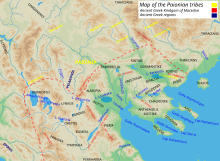
Back بايونيا (مملكة) Arabic Пеония Bulgarian Paionia Breton Peònia (regne) Catalan Peonie Czech Paionien Danish Paionien German Παιονία Greek Peonio (regno) Esperanto Peonia Spanish



In antiquity, Paeonia, or Paionia (Ancient Greek: Παιονία, romanized: Paionía), was the land and kingdom of the Paeonians/Paionians (Ancient Greek: Παίονες, romanized: Paíones).
The exact boundaries of Paeonia, like the early history of its inhabitants, are obscure; however, it is known that the region roughly corresponded to most of present-day North Macedonia and north-central parts of Greek Macedonia (i.e., likely the Greek municipalities of Paionia, excluding the village of Evropos,[1] Almopia, Sintiki, Irakleia and Serres), and a small part of southwestern Bulgaria.[2][3][4][5][6] Historical authors placed it south of Dardania (an area corresponding to modern-day Kosovo and northern North Macedonia), west of the Sredna Gora (Thracian) Mountains, and east of the southernmost Illyrians.[7] It was separated from Dardania by the mountains through which the river Vardar passes from the field of Scupi (modern Skopje) to the valley of Bylazora (near modern Sveti Nikole).
In the Iliad, the Paeonians are portrayed as allies of the Trojans. During the Persian invasion of Greece, conquered Paeonians (from as far as the Lake Prasias, including the Paeoplae and Siropaiones) were deported from Paeonia to Asia.[8]
In 355–354 BC, Philip II of Macedon took advantage of the death of King Agis of Paeonia and campaigned against the region’s northern neighbor in order to conquer them. Subsequently, the southern part of ancient Paeonia was annexed by the ancient kingdom of Macedon and was named "Macedonian Paeonia"; this province included the cities Astraion (modern Strumica), Stenae (near modern Demir Kapija) and Antigoneia (near modern Negotino).
- ^ "Ptolemy's Geography 3.13.39". LacusCurtius. Retrieved 2021-09-14.
- ^ Waterfield, Robin (2019). The Library, Books 16-20: Philip II, Alexander the Great, and the Successors. Oxford University Press. p. 428. ISBN 978-0198759881.
Paeonia is roughly equivalent to the country currently known as the Republic of North Macedonia (the former FYROM).
- ^ Roisman, Joseph; Worthington, Ian (2010). A Companion to Ancient Macedonia. John Wiley and Sons. p. 13. ISBN 978-1-4051-7936-2.
- ^ "Paeonia". Encyclopædia Britannica online.
- ^ Reames, Jeanne (2008). Howe, Timothy (ed.). Macedonian Legacies. Regina Books. p. 239. ISBN 978-1930053564.
Paeonia, roughly where the F.Y.R.O.M. is today.
- ^ Ovid; Green, Peter (2005). The Poems of Exile. University of California Press, 2005. p. 319. ISBN 9780520242609.
Ovid was lax in his geography, not least over Paeonia (in fact roughly coextensive with the present Slav republic of Macedonia.).
- ^ Strabo, "Geography", 7, Frg.4, 9.5.1
- ^ The Persian Empire: A Corpus of Sources from the Achaemenid Period (google books)